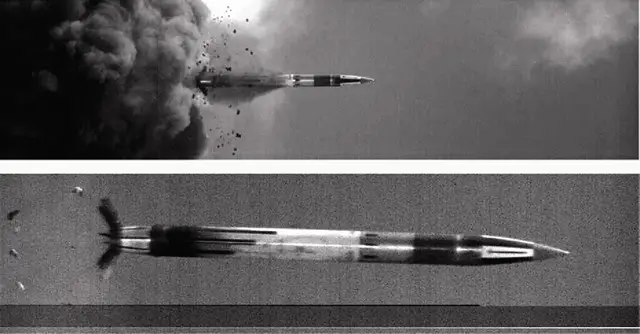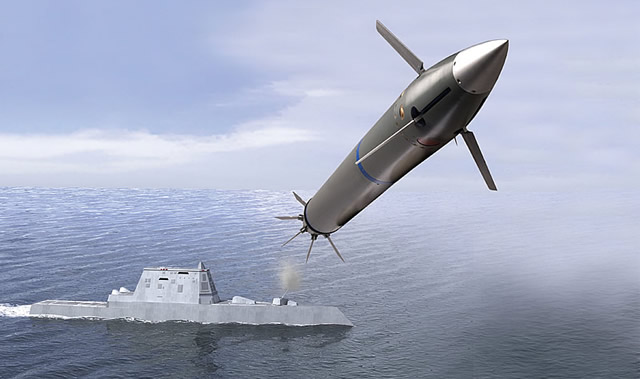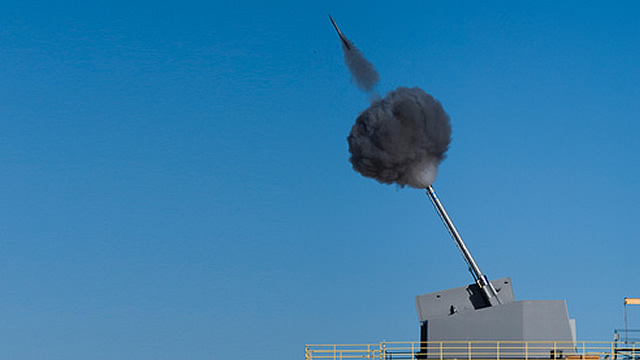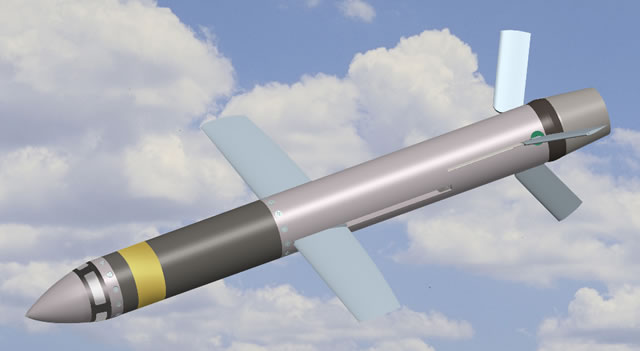| |
| a |
Focus
- LRLAP & 5 inch Navy Guided Projectile |
Lockheed
Martin is developing next gen naval gun ammunition for DDG 1000 and
DDG 51 classes |
During
a recent visit to a Lockheed Martin Missiles and Fire Control (MFC)
facility in Florida, Navy Recognition learned that the company
is working with BAE Systems and the U.S. Navy, on a new generation of
naval guns and naval guided ammunition: BAE is the prime contractor
for the Navy’s Advanced Gun System (AGS) for the Navy’s
newest Destroyer,
the DDG1000, and Lockheed Martin Missiles and Fire control is
the prime contractor for the projectile, the 155mm Long Range Land Attack
Projectile (LRLAP). |
 Lockheed Martin LRLAP during firing / flight test Picture: Lockheed Martin |
|||
155mm LRLAP
The 155mm LRLAP is set to become the primary projectile of the Advanced Gun System (AGS), the main armament of the U.S. Navy DDG 1000 Zumwalt-class destroyer. It will provide long-range off-shore precision fire support to Marine Corps and Army forces engaged in expeditionary assaults or littoral urban operations. According to Lockheed Martin, the 155mm LRLAP is both the most accurate and longest-range guided projectile in U.S. Navy history, with a maximum range in excess of 63 nautical miles. Its precision and near vertical angle of fall enables the Warfighter to defeat targets in the urban canyons of coastal cities with minimal collateral damage. |
|||
 |
|||
 BAE Systems AGS, the future DDG 1000 Zumwalt class main gun, during land based trials firing the Long Range Land Attack Projectile (LRLAP) pictures: BAE Systems |
|||
Because LRLAP has three times the lethality of traditional
5-inch Naval ballistic rounds, fewer rounds can produce similar or more
lethal effects at less cost. To withstand the gun-launch environment,
LRLAP uses an advanced rocket motor and hardened electronics, including
a global positioning system and inertial measurement unit.
A LRLAP round weighs 230 lb (104 kg) with a length of 88 in (2.2 m) and a wingspan of 18 in (0.45 m). LRLAP will be fielded in 2016 concurrent with the Initial Operational Capability for the first DDG 1000. Previous LRLAP testing was performed under subcontract to BAE Systems. All transition to production activity is being performed under direct contract to the U.S. Government. In August, 2013, Lockheed Martin received an $18 million contract from the National Warhead and Energetic Consortium to transition LRLAP to production. The contract includes developing production line tooling, test equipment and manufacturing process plans for initial production of the advanced projectile. Final assembly of LRLAP will be performed at the company’s Camden, Arkansas, facility. The guidance and control unit will be assembled at Lockheed Martin’s Ocala, Florida, facility. |
|||
 The Lockheed Martin 5-inch Navy Guided Projectile (NGP) is based on the LRALP which reduces cost and risk. Image: Lockheed Martin |
|||
5-inch NGP
The 5-inch NGP is a Lockheed Martin MFC initiative that captures critical lessons learned from our involvement in the 155 mm LRLAP program with a focus on reducing production and qualification costs as well as risks. This new generation munition is designed to counter the growing threat from Fast Attack Craft (FAC) and Fast Inshore Attack Craft (FIAC). The NGP will fire from currently fielded 5-inch 54/62 caliber naval gun systems on the DDG 51 Arleigh Burke Class Destroyers and the CG 47 Ticonderoga Class Cruisers. The NGP will be a non-rocket assisted, fire-and-forget, guided projectile with folding wings, capable of precision attack at greater than 65 nautical miles range during day, night, and all weather operations. It will employ a multi-mode sensor along with a Global Positioning System (GPS) antenna to locate and engage stationary or high-speed and highly maneuverable targets. The weapon will employ a multi-mode sensor along with a Global Positioning System (GPS) antenna to locate and engage stationary or high-speed and highly maneuverable targets. The fire-and-forget technologies and performance capabilities Lockheed Martin incorporated in the NGP to counter the FAC/FIAC threat also enable the NGP to perform the counter unmanned aerial system (C-UAS) mission and fill the naval surface fire support (NSFS) warfighting gap. According to its developer, it is the ideal weapon to support the newly evolved Anti-Access and Area Denial (A2/AD) warfighting strategy. |
|||



